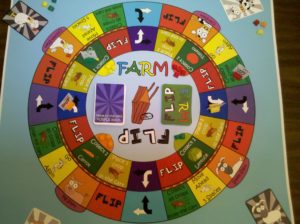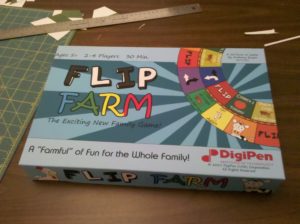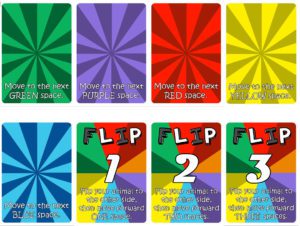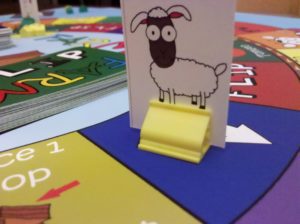 Flip Farm is a children’s board game I made at the DigiPen Institute of Technology. The project was to create a race game, where players use some sort of randomizer to reach the end goal. I took this as a challenge to create an engaging and balanced game that was simple enough for young children to play.
Flip Farm is a children’s board game I made at the DigiPen Institute of Technology. The project was to create a race game, where players use some sort of randomizer to reach the end goal. I took this as a challenge to create an engaging and balanced game that was simple enough for young children to play.
Overview – Project Details
Development Time: 1 Month
Platform: Physical
Roles: Designer, Artist
Tools: Photoshop
Gallery – Pictures
Video – Rules
Overview – Synopsis
I wanted to create a children’s game because it’s outside of my normal comfort zone. I’m a mechanics and systems designer – place me in front of a spreadsheet full of rules and interactions and I’m as content as can be. But in a children’s game, especially one for young children, you cannot have complicated movement systems, or sophisticated rulesets. Additionally, though I do play with a lot of toys, I am not a child, and this was an opportunity to create a game for a demographic that’s fundamentally different than me.
This project ended up being a lot more fun to make and play than I expected it to be. It’s easy to learn, simple to play, and very engaging for its target audience. During the course of this project, I researched movement systems, board game layouts, color design theories, character development, and much more. The lessons I learned during development of this game I have applied to all my projects since.
Details – Design Process
I started off by playing a lot of children’s games and family games. There are a lot of timeless classics that have become a part of our culture, and those games have become loved for generations for a reason. It was important to identify components of classic children’s games that made them appeal to children, and what about these games sets them apart from games for older players.
Take movement, for example. In board games that appeal to teenagers and adults, the most common method of randomization for movement is dice. In Monopoly, Backgammon, Catan, etc., dice are used because they are a fair randomizer, and the combination of multiple dice can allow for different odds or easily identifiable patterns (doubles, etc). Dice are sometimes used in children’s games, but not as frequently. Especially in games designed for young children. Spinners or cards as a randomizer for movement are quite common (Candy Land, Sorry). Cards have some good advantages over dice, such as being able to set specific odds, or ensuring that certain events must occur eventually. (Or, as a parent, being able to stack the deck in your child’s favor, at least until they get old enough to catch on!)
Another major difference is the level of player agency. The older the target player, generally speaking, the greater degree of choice the player has. In a game like Snakes and Ladders, the player has no choice – you simply move where you’re told to, with no choice of path. For young children, the act of moving the piece forward and seeing what happens is the entertaining part.
It should be noted that in Flip Farm the colored movement cards are not evenly distributed by color – there are significantly more green cards than yellow. This helps to ensure that there are always more beneficial events than negative events. Additionally, the distribution of cards creates a game that takes about the same amount of time to complete, consistently.
In my game, I wanted to improve the systems found in games like Candy Land and Snakes and Ladders. In these games, it is possible, and indeed likely, that the player will reach a penalty space, and get sent backwards. Getting sent backwards can be disheartening, especially if it’s that really big move backwards. I wanted to minimize the bad effects of a negative move. In Flip Farm, the only negative move requires the player to give up one crop. Conversely, they have an equal chance of collecting significantly more crops than they would ever risk losing. The same color tile (yellow) also gives the player an extra turn, further reducing negative impact.
I decided on a circular board, where the goal is not to reach an endpoint, but to collect tokens. In games with a fixed common path, children can sometimes become discouraged if they perceive another player as being too far ahead. The circular repeating path is an attempt to resolve this issue; it is difficult at a glance of the board to see one player as being ahead of another. While this generally only shifts the leading indicator to the scoring tokens, in playtesting, I found children to be far more focused on their own pile of tokens than those of others. The central focus is still primarily on the board.
Details – UX Design
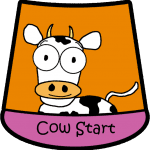
Visually, everything in the game is bright and colorful. Spaces are large, solid, and uniform in color, to make them easy to identify. Simple text is prevalent everywhere to help adults learn the game, but a large picture is also present at each element. All a child needs to do is identify colors and pictures – once they have been taught the rules, all of my child playtesters were able to play without an adult in the game.
The board is designed to help reinforce travel direction and player order. Everything moves clockwise. Along the entire perimeter of the divider between the rings of spaces are several small arrows. The blue and purple spaces have large arrows pointing in the correct direction. The character tokens are facing left on both sides to further reinforce this idea.
Details – Post-Mortem
I absolutely love Flip Farm. It was a resounding success, not just as a game, but as a learning experience. I set out to challenge myself in unfamiliar territory, and as a result learned a lot about analyzing mechanics in commercial products. I don’t claim to be an artist, but I really love the little cartoon animals I drew for this project. If you’ve seen my portfolio, you know I like to use them whenever I can – especially that chicken! I feel that thematically, my assets fit the game’s theme and gameplay very well.
I’m not really sure there’s much I would change to Flip Farm. I’ve remade the game several times to give away as gifts, and I have never felt the need to make any revisions. I am quite happy with its design and the lessons it imparts.
Download – Full Game
Would you like to play this physical game? You can download all art assets and the complete ruleset here.
If you are from a game studio? If so, please contact me to request a free ready-made copy of the game.
